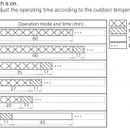Panasonic Intelli-balance 200 defrost mode
The installation manual has a table (attached) indicating time spent in air exchange vs. circulation at various temperatures in order to defrost the core. Above this table, it says “When boost switch is on.” I’m assuming that means this table describes how defrost mode will behave at 200 cfm? Does anyone know if time spent in circulation is lower when cfm is lower?
Thanks
GBA Detail Library
A collection of one thousand construction details organized by climate and house part










Replies
From what I've learned doing a deep dive into heat exchange behaviour, the IB200 is pretty similar to other units. I haven't tested the IB200 personally, but I have tested their smaller spot ERV in cold temps (which is an exhaust only defrost setup), and have been working with a Venmar unit (fully instrumented) for a few months now at temps as low as -25 C (-13 F).
The IB200 has one temperature sensor (simple thermistor) in the outside fresh air intake (OA) which you can see as part #14 (Main Body Section) in their service manual.
The temperature sensor provides a resistance value to the control board that varies quite precisely with temperature. The control board uses that resistance value and applies the defrost "logic" to match the table you included. It almost certainly runs the unit in boost mode (at 200 CFM) to do this...so the manual is a bit confusing there. The defrost times are the "safe" ones determined in testing to ensure that the core is fully warmed up before ventilation resumes.
While defrost/recirculation is going on, the ERV is running at max power, and dumping cool air into your home as the core warms up. This is where the energy penalty of defrost mode in conventional ERV/HRVs is realised as you have to heat that cool air, and run the fans at full speed.
You can confirm this by powering the unit off in cold weather (resets the internal timer) for a few minutes, then turning it on in ventilation mode. Refer to the chart to see what the ventilation time should be based on outside temperature range. If you have a long fresh air intake duct (even well insulated) the OA air entering the ERV may actually be 5-10 F warmer than actual outside air so may skew your test a bit. You'll likely hear the unit turn itself to boost mode after the internal re-circulation (defrost) damper is opened.
At lower delivery CFM settings (say you have the unit set to 100 CFM) in very cold temps, the core will also cool slower, and would not necessarily require the defrost times that are used. They don't however have extra temperature sensors in the unit to monitor this so it's back to the "safe" table and 200 CFM during defrost. This ensures they don't have customers calling with frozen up units.
I'm having good results with allowing the automation system running our test HRV to turn off defrost mode based on the air temperature leaving the core during defrost mode. Today, it's taking about 11 minutes @ 90 CFM with outside temps at -25 C.
Thanks Dennis! I think I understand. Restating just to confirm I've got it right.
The outdoor fresh air intake temperature in the ONLY thing that will determine how often and how long the circulation phase is, and circulation will always be at 200 cfm. Air exchange at lower CFMs will not alter how often and how long the circulation phase is.
Examples
Supply 60 cfm, Exhaust 60 cfm @ -15 F: 27 min in air exchange @ 60 cfm, 11 min in circulation @ 200 cfm
Supply 150 cfm, Exhaust 150 cfm @ -15 F: 27 min in air exchange @ 150 cfm, 11 min in circulation @ 200 cfm
The reason you say "cool air is dumped into the house" is because the warm air from inside the house is being circulated through a cold core? Air temperature exiting at supply vents is colder than the air temperature entering at the exhaust vents until the core warms up to room temperature?
Yes, outside air temp is all that is used to control defrost cycles. On the 200 CFM during defrost, I'm 99% sure that is correct.
Yes, your examples should play out accurately :-)
Yes, warm house air is circulated through the core, with a similar effect to running a duct into and out of your refrigerator. If you monitor air temps on the supply side (assuming you don't have a post HRV/ERV heater) you'll see that that they start off cool, and then gradually warm up towards the unit's stale air intake temp. That temperature drop will be addressed by your house heating system, so has a real cost with respect to BTUs.
The NRC has done some in depth studies in this department: https://publications.gc.ca/collections/collection_2021/cnrc-nrc/NR24-43-2020-eng.pdf
You can review all the technical data there, or just skip to page 26 for the conclusions. I figure pre-heat and post-heat will be a popular topic as polar air combined with high energy costs coincide this week :-(